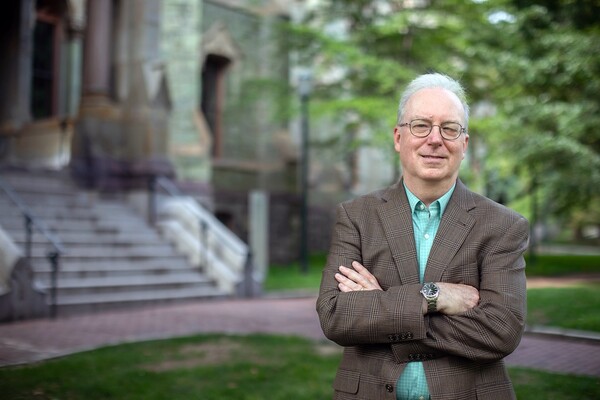
nocred
Peru has the highest per capita COVID-19 death rate in the world, twice that of the United States. In the U.S., despite abundant availability of vaccines that could have driven that rate even lower, vaccine hesitancy, fueled in part by misinformation spread on social media, has kept millions from receiving the shots.
The nuances that have informed the trajectory of the COVID-19 pandemic in these two countries provided timely fodder for students in the course Parallel Plagues: Infectious Diseases and Their Control in Peru and the U.S.. Taught by the Perelman School of Medicine’s Michael Levy and César Ugarte-Gil of Peru’s Universidad Peruana Cayetano Heredia (UPCH), who is also a scholar with Penn’s Center for Global Health, the course—with sessions on rabies, Lyme disease, HIV, tuberculosis, malaria, COVID, and other “plagues”—urged students to consider how historical, social, political, economic, and other forces shape disease planning and response in the two nations.
“We have eight students in Peru and eight at Penn, and in each class we have two experts, one from each country,” says Levy. “We spend a week on each pairing, taking the first day to explain the problems and the second to talk about solutions and barriers to solutions.”
Rather than learning about these issues at an academic level of remove, the course format put experts and students from each country into conversation. Their on-the-ground experiences lent the course discussions both authority and up-to-the-minute relevance for the students, many of whom are or soon hope to be health care providers or public health workers.
“This is a very special class,” says Priya Rajagopalan, a student in Penn Medicine’s Master of Public Health Program. “This class helps students from both the U.S. and Peru to come together and learn from each other. Pairing students for projects helps us learn by asking and refining questions, debating ideas, and drawing conclusions. The class has not only enriched my experience but helped me understand public health policies on infectious diseases for both the U.S. and Peru.”
Levy is an epidemiologist whose interdisciplinary work has focused on Chagas disease but extends to subjects as diverse as bedbug infestations and the effect of evictions on the COVID-19 pandemic. He had talked for years with colleagues about teaching a course like this, the two-country approach informed by how he runs his own zoonotic disease laboratory, which is based in Arequipa, Peru, and includes researchers from both Penn and UPCH. “I like to have students studying parallel problems in each country,” he says.
The COVID-19 pandemic not only supplied a topic for class discussion, but it also opened the world of online coursework, a format that, in Levy’s view, enhanced the course.
“The original idea would have been to fly faculty, and students who were able, from Penn to UPCH and vice versa for a couple weeks,” he says. “I feel like the interactions amidst the students were better and more natural than they would have been had we flown in and out for a short time."
Each week the class focused on a different disease, or a pair of similar diseases, one affecting the U.S. and one Peru. Both Levy and Ugarte-Gil presented on areas of their own expertise: Chagas disease and bedbugs for Levy and tuberculosis and hepatitis B for Ugarte-Gil. They also engaged more than a dozen other guest speakers, including Penn’s Stacey Trooskin, Gregory Bisson, Ricardo Castillo-Neyra, Kayleigh O’Keeffe, and Alison Buttenheim.
The presentations and discussions put a spotlight on the differences between the countries, as well as on similarities.
A week focused on mosquito-transmitted diseases, for example, compared mosquito control aimed at combating dengue in Peruvian rainforests to efforts aimed at reducing West Nile virus and nuisance mosquitoes in the northeastern U.S.
“The strategies to get people in the community to do mosquito control are very different in the jungle of Peru than they are in U.S. cities and suburbs, but many of the barriers are quite similar,” Levy says.
It’s made me have a stronger appreciation for how policies that the government sets, that I take for granted, can have lasting and severe consequences on the health of a population.
Mike Noji, Ph.D. student in the Perelman School of Medicine
During the week focused on COVID, Penn’s Buttenheim and Larissa Otero, a doctor and faculty member at UPCH, offered overviews of the pandemic in each country. Since the start of the pandemic, Buttenheim, from the School of Nursing, has focused on vaccine uptake and hesitancy as well as COVID-19 mitigation strategies. From that experience, she told the class, she has seen that policymakers in the U.S. have been eager for ready-made solutions to encourage vaccination and public health-promoting behavior. Yet researchers like Buttenheim and her colleagues have noted that a rush to implement something often came at the expense of opportunities to do rigorous research that would test which strategies were most effective.
“The refrain from policymakers was, ‘Tell us what works,’” Buttenheim told the class. “’We just need a playbook; we don’t have the time or bandwidth to learn new things about vaccine rollout and vaccine demand.’”
Meanwhile, shedding light on the situation in Peru, Otero explained that, despite Peru being a middle-income nation and having made significant gains in measures of public health during the last decade or more, its people have suffered disproportionately poor outcomes from COVID, attributable in large part to socioeconomic inequities.
“We’ve seen huge increases in access to health services but still have large health disparities,” Otero said. Even looking solely within the capital city of Lima, she noted, “most districts had death rates that were low, comparable to European nations, but several had much higher rates.”
The U.S. is far from being immune from such disparities, Buttenheim noted, as COVID has put on full display. Placing these two nations side-by-side in this context was illuminating for students like Alicia Maldonado, who recently earned her M.D. from UPCH.
“When you are in medical school, you are taught about a disease from a purely scientific point of view and only read a little about the risk factors for acquiring a disease,” says Maldonado. “However, in this course, as we all had a foundation on the biological causes of the diseases, we moved forward to discuss the how and the why of these risk factors—migratory status, ethnicity, gender, among others—in a way that I have never done before.”
For Mike Noji, a Ph.D. student in the Perelman School of Medicine, the comparative nature of the course and varied viewpoints of the professors and guest speakers underscored the role of government policy in infectious disease outcomes. “It’s made me have a stronger appreciation for how policies that the government sets, that I take for granted, can have lasting and severe consequences on the health of a population,” he says.
For the midterms and final projects, students formed pairs—one student from Penn, one from UPCH—to look at historical infectious disease outbreaks and emerging and future diseases in each country. Discussions and breakout group work throughout the semester offered students additional avenues for appreciating and comparing public health issues across countries.
Tyler Lavender, who is pursuing both a V.M.D. at Penn’s School of Veterinary Medicine and a master’s of public health, says that the interaction with his peers was part of what made the course so valuable.
“I feel privileged to have been part of these discussions with such smart people,” Lavender says. “For me, I definitely did not know as much about the human-specific diseases, like tuberculosis or HIV, and a lot of the students in Peru were already doctors. Hearing them say, ‘Here are the issues we face in human medicine,’ was illuminating. And I like to think that when it came to zoonotic or vector-borne diseases, I was able to offer some insights from the veterinary or zoonotic side of things.”
Levy would like to capture this kind of exchange and synergy in future offerings of this course. He also hopes its structure can inform future research and exchange programs.
“Working on parallel problems is kind of my solution to the trap of colonialism that these kinds of projects can fall into,” he says. “Now I’m thinking that maybe we can do parallel thesis projects, going back and forth to get two different perspectives. It’s a new way to do exchange that I’m hoping to keep going.”
And by broadening their worldview and perspective, students say that lessons from the course have the power and potential to resonate through their future careers.
“As a doctor having recently finished medical education, I have to deal with the individual level of control of infectious diseases, which I’m passionate about,” says Víctor Arles Vega Zambrano, a student at UPCH, “but with this course I completely changed my mind and recognized the importance of developing overarching policies and interventions to control infectious disease. If we don’t understand infectious diseases as social problems, we will not be able to really control those diseases. That understanding will definitely impact my future practice as a doctor.”
Katherine Unger Baillie

nocred

Image: fcafotodigital via Getty Images

Image: Mininyx Doodle via Getty Images

Charles Kane, Christopher H. Browne Distinguished Professor of Physics at Penn’s School of Arts & Sciences.
(Image: Brooke Sietinsons)